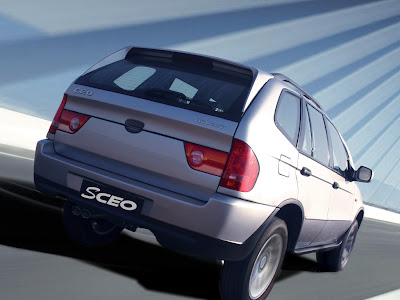
(Source: http://web.ead.anl.gov/uranium/guide/index.cfm, Depleted UF6 Management Information Network)
The basic steps involved in the process of uranium mining to the production of nuclear reactor fuel are shown in the diagram. Uranium ore is mined, and then transported to a milling facility where it is refined to uranium oxide. The oxide (yellowcake) is then converted to uranium hexafluoride to undergo enrichment. The enriched product can then be processed to reactor fuel for electricity generation via nuclear reactors.

The Big Eagle open pit mines on the south slope of Green Mountain near Jeffrey City, Wyoming. (Picture courtesy of: www.usnrg.com, U.S. Energy Corporation)
THE STAGES IN MINING AND MILLING
1) EXPLORATION Before mining can actually take place, the uranium ores are located by radiological studies. With the highest-grade deposits buried in deep rock formations, advanced technologies like satellite imagery, geophysical surveys, multi-element geochemical analysis and computer processing are used to search for the deposits. The potential deposits are drilled, and samples are extracted for studies by geologists. It is a long procedure that involves detailed geological and economic evaluation of the grade and characteristics of the orebody. Mining engineers must then develop a mining plan to extract the ore. If the project has potential, environmental impact assessments and the public consultation process begin in order to file applications for regulatory approvals of the project. It is only after permits and licences are in place, that mine activities can begin. It can take decades before a discovery of an orebody can lead to electricity production. For example, Cameco’s McArthur River mine took 12 years to result in commercial production.
2) EXTRACTION Uranium-containing ore is retrieved. Uranium occurs in a variety of ores, and is traditionally mined from open pit or underground mines by drilling and blasting techniques. If the uranium ore is found near the surface, (less than 100 metres deep), the open pit mining method can be used. This method removes the surface soil and rock, and the pit is excavated to access the ore. If the ore is located further below the surface, underground mining methods are more economical. To access the ore, vertical shafts are dug and then tunnels called drifts, are cut directly to the deposit.
The uranium content of the ore is extremely low (usually less than 0.3%), so large amounts of the ore have to be mined. For example, Olympic Dam has an ore grade of 0.05%, which means that for every tonne mined, only 5kg of uranium is retrieved. Thus, large amounts of waste rock are produced during this process. In some cases the ore may be extracted by in situ leaching. This process extracts the uranium from underground by dissolving the uranium from the ore, and then pumping uranium-bearing solution to the surface.

Did you know that uranium is one of the most abundant elements in the earth’s crust? (Picture courtesy of:www.cameco.com, Cameco Corporation)

Cameco’s Key Lake Open Pit Mine in 1994 (Picture courtesty of: www.cameco.com, Cameco Corporation)
3) CRUSHING The ore is usually processed at milling facilities close to the mine site in order to minimize transportation costs, as well as to prevent release of the products into the environment. The ore must be crushed and grinded into smaller fragments. After initial crushing, the ore is passed through a mill which grinds the rock further into a fine powder. It is this process that creates the fine particles that can readily be emitted into the environment. The small size of the rock increases the radioactive surface area, and also makes it difficult to completely isolate from the surroundings.
4) CHEMICAL LEACHING In this process, large amounts of water, sulphuric acid and thickener are added to the ore powder.
The UO2 is oxidised to UO3:
UO3 + 2H+ ====> UO22+ + H2O UO22+ + 3SO42- ====> UO2(SO4)34-
The uranium is able to bond with the acid, and as a result about 90% of the uranium can be separated from the host rock.Sulfuric acid leaching is the most common method, but some mills require alkaline leaching when the ore has basic components which can react heavily with acid.
5) PRECIPITATION and DRYING The uranium solution is purified by ion exchange systems and solvent extration technologies. When the uranium precipitate is extracted from solution, filtered and dried, the product is a yellow uranium oxide (U3O8), called “yellowcake”. Yellowcake contains between 60% and 90% uranium by weight.
6) STORAGE and SHIPPING The yellowcake is then transported to enrichement facilities to be processed to reactor fuel.
Uranium Oxide (Yellow Cake)


 CO2 + 2H2O
CO2 + 2H2O



























































































.jpg)


















.bmp)
























































.jpg)

